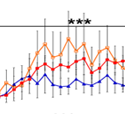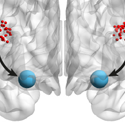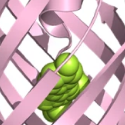Hot Off the Press – April 24, 2024 Published in Molecular Psychiatry by Atul Daiwile and Jean Lud Cadet, et al. from the NIDA IRP Molecular Neuropsychiatry Section. Summary Methamphetamine also called METH, crank, ice etc. is a powerful stimulant that has caused addiction in a lot of people in the world. Humans who take… [Read More]
News Main
NIH Green Labs Program
Congratulations to the NIDA labs who participated and received awards in the 2023 NIH Green Labs Program! Molecular Neuropsychiatry Section, Adjei, Nasser – Gold Translational Analytical Core, Kryszak, Lindsay – Silver Neuronal Circuits and Behavior Section, Sarsfield, Sarah – Silver Integrative Neuroscience Research Branch, Neuronal Networks Section, Barbano, Flavia – Bronze Molecular Targets and Medications… [Read More]
Different Effects of Peer Sex on Operant Responding for Social Interaction and Striatal Dopamine Activity
Hot Off the Press – April 18, 2024 Published in The Journal of Neuroscience by Jonathan Chow, Kayla Pitts and Yavin Shaham, et al. from the NIDA IRP Neurobiology of Relapse Section. Summary Recent studies have shown that when rats are given a mutually exclusive choice between social interaction with a peer and an addictive… [Read More]
Midbrain signaling of identity prediction errors depends on orbitofrontal cortex networks
Hot Off the Press – April 10, 2024 Published in Nature Communications by Qingfang Liu and Thorsten Kahnt, et al. from the NIDA IRP Learning and Decision-Making Unit. Summary In this study, Qingfang Liu (Research Fellow in the LDMU) and colleagues show that identity prediction errors in the dopaminergic midbrain are computed based on outcome… [Read More]
GPR55 is expressed in glutamate neurons and functionally modulates drug taking and seeking in rats and mice
Hot Off the Press – April 4, 2024 Published in Translational Psychiatry by Yi He, Hui Shen and Zheng-Xiong Xi, et al. from the NIDA IRP Addiction Biology Unit and Magnetic Resonance Imaging and Spectroscopy Section. Summary G protein-coupled receptor 55 (GPR55) is a putative cannabinoid receptor, which has been considered as the “CB3” receptor, as… [Read More]
Relapse after electric barrier-induced voluntary abstinence: A review
Reviews To Read – April 2024. Published in Current Opinion in Neurobiology by Kenichiro Negishi and Yavin Shaham of the NIDA IRP Neurobiology of Relapse Section. In this review we introduce the electric barrier conflict model of drug relapse and review studies on behavioral and neuropharmacological mechanisms of cue-induced relapse and incubation of drug seeking (time-dependent… [Read More]
A linguistic analysis of dehumanization toward substance use across three decades of news articles
Featured Paper of the Month – April 2024
Published in Frontiers in Public Health by Salvatore Giorgi and Brenda Curtis, et al. of the NIDA IRP Technology and Translational Research Unit.
In this work, we apply a computational linguistic framework to measure dehumanization to 3 million news articles. We show that popular media in the U.S. has dehumanized people who used substances to varying degrees. Substances such as heroin have been strongly dehumanized for decades, while marijuana use is becoming less dehumanized over time, aligning with increased public support for legalization.
µ-Opioid receptor antagonism facilitates the anxiolytic-like effect of oxytocin in mice
Hot Off the Press – March 26, 2024 Published in Translational Psychiatry by Khalin Nisbett, Leandro Vendruscolo and George Koob from the NIDA IRP Stress & Addiction Neuroscience Unit and Neurobiology of Addiction Section. Summary Nisbett et al. discovered that the anxiolytic-like (anxiety-reducing) effect of oxytocin can be modulated by the endogenous opioid system. We… [Read More]
Yasmin Padovan-Hernandez recieves Graduate Student Research Award
Yasmin Padovan-Hernandez, a graduate student working in the Aponte Lab, received a 2024 NIH Graduate Student Research Award (NGSRA) for the poster she presented at the NIH Graduate Student Research Symposium on February 15, 2024. Yasmin’s poster was titled was “Hypothalamic Circuits Controlling Interoceptive Hunger”. There were 12 winners out of over 120 posters. Yasmin… [Read More]
Technology Development Initiative – Paper of the Month – March 2024
Adaptable, turn-on maturation (ATOM) fluorescent biosensors for multiplexed detection in cells Nature Methods
This paper by Sekhon et al, 2023 describes the creation of turn-on fluorescence sensors coupled to either monobody or nanobody. The fluorescent sensors can be paired with a monobody/nanobody to your protein of interest and optimized for fluorescence intensity.
[Read More]










